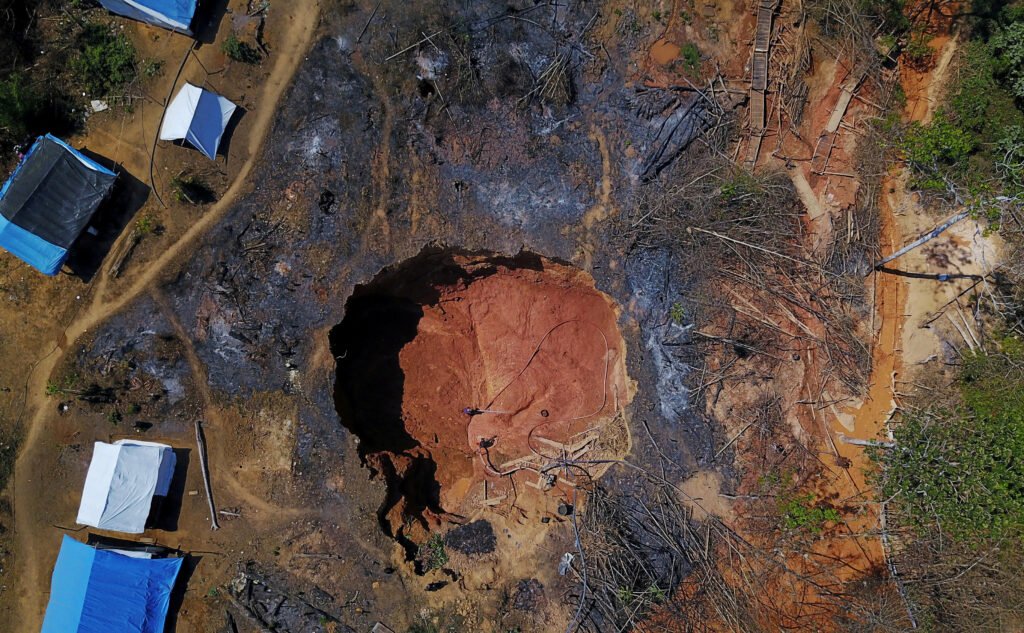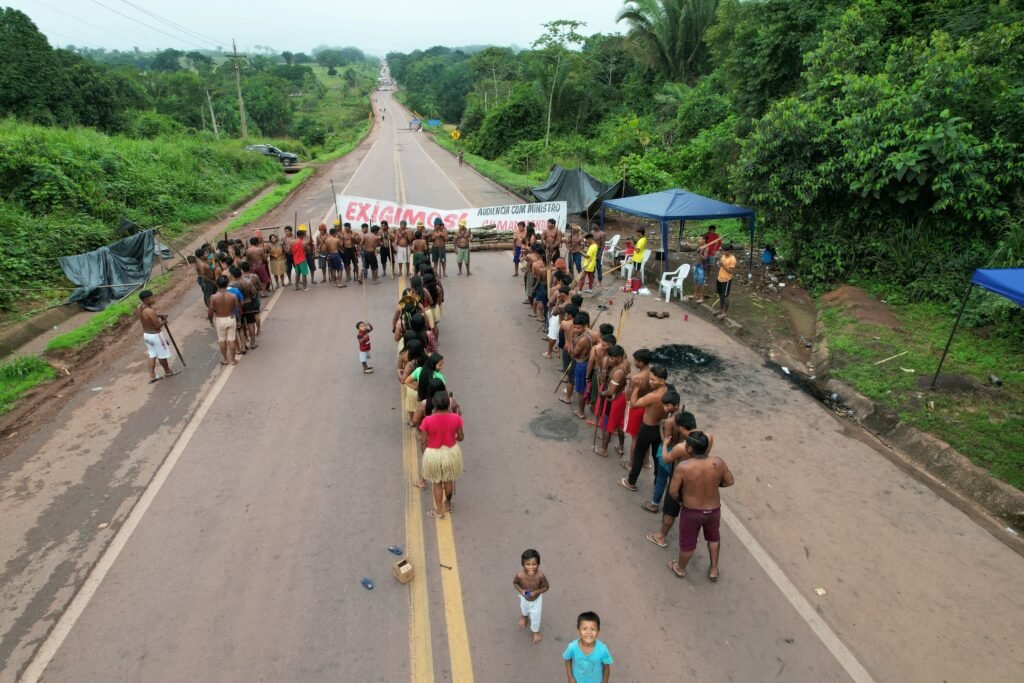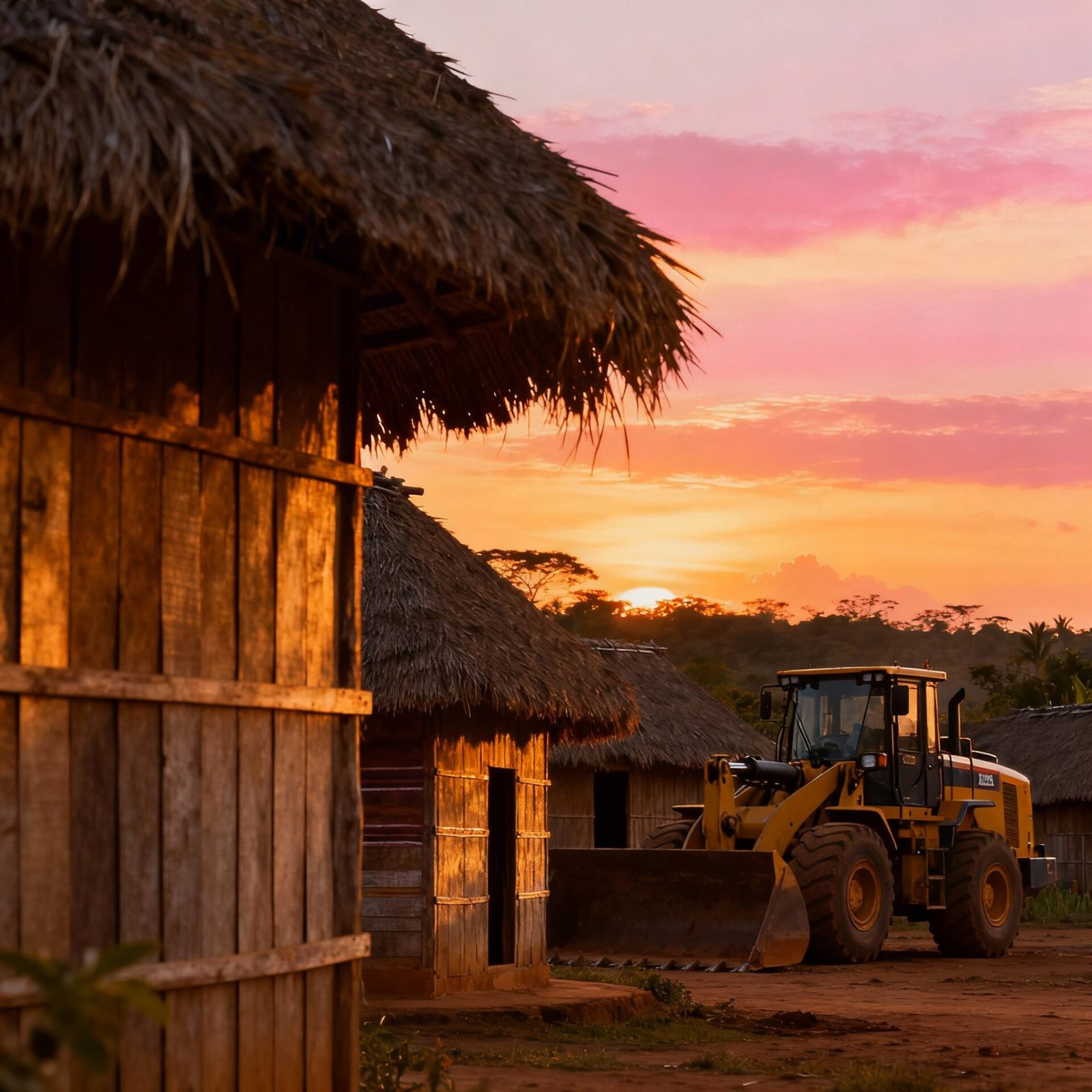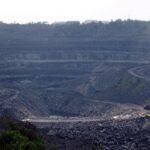The forcible expropriation of Indigenous lands in Brazil has escalated into a full-blown crisis. Since at least 2020, powerful agribusiness, illegal miners and cattle ranchers have been invading territories recognized as Indigenous homeland, often with state acquiescence or negligence.
New laws and policies under former President Jair Bolsonaro dismantled protections, while even the Supreme Court’s defense of Indigenous rights faced legislative backlash. The result is an unprecedented surge in land-grabbing and forced displacement. In one case, Brazilian prosecutors found “farmers, illegal miners and land grabbers” could now occupy Indigenous lands under a lax 2020 regulation, leading to over 250,000 hectares (620,000 acres) seized in just two years.
In Amazonia and beyond, Indigenous families report threats, violence, and hunger. A top Brazilian prosecutor warns many invaders “expect that the territories will no longer be Indigenous”.
This investigative report documents the scale and human impact of the land grab and displacement of indigenous communities in Brazil from the Yanomami in the far north to the Guarani-Kaiowá in the south using government data, NGO studies and voices of Indigenous leaders.
Historical Context: Indigenous Lands and the Brazilian Constitution
Brazil’s 1988 Constitution is often hailed for recognizing Indigenous peoples’ inalienable rights to their ancestral lands. After centuries of dispossession and violence (dating back to colonial times and intensified under the 1964–85 dictatorship), the constitution guaranteed Indigenous tribes a share of the Amazon and other forests.
Demarcation of Indigenous territories proceeded slowly through the late 20th century, but by 2018 Brazil legally recognized around 300 Indigenous territories covering over 130 million hectares (almost 20% of national territory), the majority in the Amazon basin. Historically, these lands were largely insulated from large-scale farming or mining until recently. For decades, illegal loggers and miners staged raids in remote areas, but enforcement and leftist governments (1990s–2010s) often pushed back to some extent.
Timeline of key legal landmarks:
- 1988: New constitution enshrines Indigenous land rights, environmental protections.
- 1990s: Slow demarcation of core territories; enforcement gaps remain.
- 2019: Jair Bolsonaro takes office vowing to open Indigenous lands to businesses.
- 2020: FUNAI (Indigenous Agency) issues Normative Instruction 9, easing registration of non-Indigenous claims.
- 2023: Brazil’s Supreme Court strikes down the “Marco Temporal” cut-off, then Congress overrides it to reimpose an 1988-era land claim limit.
Throughout, Indigenous leaders insisted any “cutoff date” ignores centuries of forced displacement. Indeed, a 2023 court rejected the “Marco Temporal” thesis, recognizing rights beyond the constitution’s enactment.
But Congress immediately passed a new law (Law 14.701/2023) reasserting the cutoff and loosening environmental rules, a move Indigenous activists called a “betrayal” of constitutional guarantees. By mid-2025, thousands of Indigenous demonstrators had mobilized across Brazil demanding repeal of the new law and protection of their lands.
Bolsonaro Era and the Surge in Land Grabbing
Under President Bolsonaro (2019–2022), Brazil saw a dramatic spike in deforestation and violence on Indigenous frontiers. His campaign vows, “not one more centimeter” of Indigenous land (promised on inauguration) translated into real policy shifts. Federal agencies were weakened, enforcement slacked, and invasive projects proliferated. For example:
Normative Instruction 9 (Apr 2020): This regulation enabled local FUNAI offices to grant or approve occupation of Indigenous lands by outsiders. Within two years, over 250,000 hectares of Indigenous territory were certified as private farmland by invaders in dozens of reserves. The most dramatic case was in Maranhão state, where a single reserve saw 69,000 hectares certified to outsiders.
Deforestation Rates: Amazon deforestation leapt to a 15-year high under Bolsonaro. (Half of Brazil’s greenhouse emissions come from land-use change; 60% of the Amazon lies in Brazil) A Human Rights Watch report noted Bolsonaro’s rhetoric and actions “effectively gave a green light to the criminal networks” accelerating forest clearing and violence.
Violence and Murders: Environmental defenders and Indigenous leaders faced unprecedented danger. In 2019 alone, at least 113 Indigenous people were murdered in Brazil, almost all defending territory from loggers, miners and ranchers. (That year, another 81 people were victims of attempted murder.) These crimes spanned tribes from the Guajajara and Guarani-Kaiowá to the Yanomami. Such violence was described by one Indigenous leader as “a surge, our lives and land are under attack”.
Promises vs. Policy: Bolsonaro repeatedly celebrated “opening” protected areas and reducing demarcation. As Yale Environment 360 reported, Bolsonaro’s government backed two Congressional bills that would strip Indigenous peoples of lands taken before 1988 and allow mining on their territories without consent. These bills collectively aimed to “legitimize” land grabbers’ claims and bypass demarcation procedures.
The impact has been profound and brutal. Indigenous communities describe a transition from isolated threats to a pervasive siege. “We live in fear and we’re always wondering, when will they kill us?” said Hekurari Yanomami, president of the Yanomami Health Council, of the waves of armed miners on his land. In Mato Grosso do Sul, Guarani-Kaiowá families tell of armed gunmen burning their villages. Even in Atlantic Forest remnants, Pataxó and Kambiwá people were chased from donated lands by gunmen hollering “Feathers are going to fly!”.
Bolsonaro’s legacy: By late 2022, illicit occupation had become the norm. An NGO study found that in 49 separate Indigenous territories, outsiders had registered large farms on tribal land, altogether more than 250,000. In Mato Grosso do Sul, one Guarani-Kaiowá reserve saw 21% of its area (12,000 of 56,000 ha) secretly titled to invaders. Brazilian prosecutors warned this one-sided trend created “legal uncertainty” by mixing private property claims into Indigenous lands.
Case Study: Yanomami – Malnutrition and Mining
The Yanomami of northern Amazonia have become a tragic symbol of the crisis. Their half-million-hectare reserve straddles Roraima and Amazonas states and is home to ~30,000 people across 367 villages. Decades ago the territory was largely intact, but after 2018 illegal gold mining exploded. Under Bolsonaro it soared; in 2020 an estimated 20,000 garimpeiros (wildcat miners) were scouring Yanomami land for gold. By 2023, Brazilian health officials tallied 308 Yanomami deaths in a single year from disease and starvation (50% children under age four).
Illegal mining has direct lethal effects. Mercury used by miners poisoned fish and water, causing birth defects and paralysis. Malaria and respiratory infections (spread by crowded mining camps) tripled among Yanomami. Worst of all, whole villages suffered hunger. In early 2023, photos and reports of severely malnourished Yanomami children shocked the nation. President Lula da Silva’s health ministry officially declared a medical emergency and brought in food aid. As Lula visited a Yanomami clinic he declared: “More than a humanitarian crisis… it’s genocide: a premeditated crime against the Yanomami”.

Local accounts and photography (Reuters) revealed the human toll: children with distended bellies, elderly frail as bones, communities too sick to hunt or farm. As Yanomami shaman Davi Kopenawa put it, “Illegal mining is so bad for us”.
In December 2023 alone, Brazil’s environmental agency (IBAMA) reported destroying 90 mining camps in Yanomami land. But without sustained military support, large operations bounced back. One IBAMA official warned flatly: “If we lose military support… we will lose all this year’s work”. Indeed, when the Air Force pulled back in mid-2023, miners returned to remote streams by boat and helicopter.
By April 2024, 570 Yanomami children had died of curable illnesses over Bolsonaro’s four yearsreuters.com. Even under Lula, new challenges emerged. In early 2025, violent incidents flared: armed gunmen in speedboats shot at villages that resisted miners’ entry. These attacks on unarmed Indigenous camps added to the sense that lawlessness prevails: as one prosecutor put it, lawlessness on Indigenous lands is “widespread” and under-enforced.
Case Study: Munduruku – Gold and Protest
Far to the southeast in Pará state lies the 2.4-million-hectare Sawré Muybu (Munduruku) Indigenous land along the Tapajós River. The Munduruku people (≈6,500 inhabitants) have long struggled to expel illegal gold miners from their rivers and forests. Under Bolsonaro, pressure grew: satellite monitoring showed a 363% jump in areas devastated by mining on Munduruku land between 2019 and 2021. By late 2024 a federal police sweep (Operação Munduruku) temporarily cleared dozens of mining camps, but villagers warned miners would simply return once the operation ended.

The Munduruku case became a flashpoint of resistance. In March–April 2025, leaders blocked the BR-230 highway, halting grain shipments to force the Supreme Court to reconsider a 2023 law (No. 14,701) that would limit Indigenous claims (the “Marco Temporal” law)reuters.com. For nearly two weeks, trucks at the barricade bore signs like “Fora MPI” (Remove the Plantation Statute) and “Munduruku Warisau” (“Stop Munduruku Genocide”).
The protest ended only when Supreme Court Justice Gilmar Mendes agreed to meet the demonstrators. Their spokesperson warned: “We won’t stand down,” recalling a history of broken promises. Munduruku activist Alessandra Korap (Goldman Prize laureate) asked publicly: “How many lives will be destroyed if this bill passes?”.
Illegal mining on Munduruku lands also poisoned local rivers with mercury and fueled conflict. Federal statistics (2021) confirm Munduruku territory was among the worst-hit in Brazil, with gold mining sites sprawling across riverbanks. Health monitors documented mercury levels in fish far above safety limits. In one village, years of mining has correlated with higher miscarriages and infant death. The Munduruku Association estimates that unless enforcement is continuous, the miners “will come back”. This cat-and-mouse dynamic underscores how land grabbing and environmental harm are inseparable in Brazil’s Amazon.
Case Study: Guarani-Kaiowá – The Agribusiness Frontier
In Brazil’s south-central plains (Mato Grosso do Sul), the Guarani-Kaiowá people have faced a century of loss as sugarcane and cattle ranches swallowed their land. Their modern reserves are tiny fragments of ancestral territory, often surrounded entirely by farms or ranch roads. Land grabbing here tends to be by powerful landowners rather than miners, but the effects are the same: communities face chronic food insecurity and have little political clout.
Mongabay reports that in recent years, even formally demarcated reserves are being illegally infiltrated. For instance, the Dourados-Amambaipeguá reserve (home to Guarani-Kaiowá communities) lost more than 12,000 hectares (almost 30,000 acres) of its legal area to unauthorized farms since 2020. Today that’s about one-fifth of the reserve. Local authorities admit it’s common for logging and ranch interests to register land titles inside reservation boundaries under dubious paperwork. When prosecutors challenged this “Normative 9” loophole, some state courts briefly barred its use, but enforcement remains uneven.
Guarani-Kaiowá leaders paint a picture of slow-motion ethnic cleansing. Villagers report regular harassment by masked gunmen who herd cattle onto their fields, poison their wells, or burn crops. One indigenous teacher told National Geographic in 2023 that families live “always fearing new invasions”, and that the local hospital frequently treats arrow wounds from clashes over water sources. The trauma is generational: many elders recall open violence from earlier decades, and today youth remain committed to regaining land through non-violent protest and legal claims. Still, hunger and displaced life on reservation’s edges take a toll.
(For brevity we won’t detail every Indigenous nation, but note that nearly all of Brazil’s 305 tribes are affected. For example, the Kayapó in Pará similarly face ranchers encroaching via illegal logging roads, and the Kaingang in the south see decades-old timber logging leases moving into reservation forests. Even coastal tribes in Bahia and Espírito Santo report mining companies eyeing areas under the guise of “reviving old claims.” The scope is national.)
Indigenous Voices: Testimonies from the Frontlines
First-hand accounts bring the crisis into focus. Several Indigenous leaders and community members were interviewed by journalists:
Avelin Buniacá Kambiwá (Pataxó Hã-Hã-Hãe, Bahia): When his family settled a donated 89-acre forest in 2021, land-grabbers attacked them. Buniacá recounts: “They started shooting into the trees, setting fire around our homes, threats to slit our throats… Some families left. It’s our land, our home, but they were too afraid to stay here.” Later, leading a reconstituted Katurãma village on another site, he pledged: “The lives of Indigenous people depend on the land… They try to take [it] over and over again, but we won’t stand down.”
Hekurari Yanomami (Yanomami leader, Roraima): “‘We live in fear and we’re always wondering, when will they kill us?’” he said, describing armed garimpeiros increasingly present in villages. Yanomami leader Davi Kopenawa (whose activism helped win the 1992 Yanomami Park) similarly warns, “Illegal mining is so bad for us.”
Alessandra Korap Munduruku (Munduruku activist): A Tapajós River farmer and Gold Laureate, she has said of Congress’s coup against Indigenous rights: “How many lives will be destroyed if this bill passes?”. She joined protests, emphasizing that land rights are “a matter of survival” for her people.
Luis Mendonça (local official, Pará): A prosecutor for the Federal Public Ministry, he told Mongabay that under Bolsonaro “Normative 9… was favoring the illegal occupation of public lands and exacerbating land conflicts,” noting dozens of lawsuits had been filed to undo it.
Sonia Guajajara (National Indigenous leader and minister in Lula’s government): Of the Yanomami emergency, she declared on Twitter: “We must hold the previous government accountable…for adults weighing like children, and children reduced to skin and bones.”.
These voices underscore the human stakes. Even where communities have legal title, they face constant threat. An emblematic sentiment is that of one Katurãma elder: “They can move us off the land, but we do not live on land – the land lives through us.” (This expresses the deep cultural tie to territory which forced evictions rupture.)
Comparative Global Context: A Widespread Pattern
Brazil’s crises echo struggles on other continents. It is part of a global pattern where Indigenous and rural communities face powerful interests:
Asia: In 2020 the UN Special Rapporteur noted that across Asia, “Indigenous people are facing massive displacement due to land-grabbing” by dams, plantations, mining and logging. Countries like Cambodia, Indonesia and the Philippines have seen villagers evicted without consent for palm oil plantations or mines. The warning applies to Brazil too: large-scale development projects in Amazonia similarly uproot communities under cover of law and corruption.
Africa: In Tanzania’s Loliondo game reserve (northern Serengeti region), authorities forcibly evicted 70,000 Maasai pastoralists between 2017–2022 to create a luxury safari zone. Security forces burned over 90 villages, beat and arrested protestors, and sent about 2,000 people fleeing across the Kenyan border. Local leaders protested that their cattle (and livelihoods) were being taken but no justice was offered, a scenario chillingly similar to Amazon deforestation zones.
Latin America (Chile): The Mapuche, Chile’s largest Indigenous group, have waged decades-long struggles to recover lands taken during colonial and dictatorship eras. In recent years, Mapuche activists have burned logging trucks and blockaded roads, saying forestry companies act as “colonists” on stolen territory.
One Mapuche leader noted there has been “no change since democracy started” as corporate interests continued to occupy their lands. The parallels are clear: traditional communities opposed land-based development, whether corporate or state-backed, face repression worldwide.
These comparative cases reinforce that Brazil’s Indigenous land crisis is not an isolated oddity but part of “land grab” phenomena recognized by organizations like Human Rights Watch and Global Witness. In all cases, governments invoke development or security, while communities report violence, losing not only homes but cultural survival.
Government and Policy Response
The Brazilian government’s response has been uneven. After decades of neglect, the current administration has promised a course correction:
Under Lula (2023–): President Lula da Silva has explicitly vowed to defend Indigenous territories and end illegal mining. His Interior (Indigenous Affairs) Minister Sonia Guajajara announced airlifts of food supplies to starving Yanomami villages, and the armed forces re-engaged in anti-mining operations. By mid-2023 over 500 federal agents had destroyed dozens of mining camps in Munduruku and Yanomami territories. The government also reinstated environmental agency budgets and reinforced FUNAI’s demarcation mandate. Crucially, Lula signed a decree formally establishing an Indigenous Affairs ministry (SNU) to coordinate protection.
Judicial victories: In 2023, Brazil’s Supreme Court emphatically ruled (9–2) that Indigenous land rights are not limited by the 1988 “Marco Temporal” date. This landmark decision affirmed that centuries of dispossession cannot be undone by a bureaucratic cutoff. It also sparked a wave of high-profile cases: in late 2024, the Court recognized the Raposa Serra do Sol reserve (Guarani-Waiãpi land in Roraima) in full and adopted an expansive view of consultation rights.
Conflicting Congress: Despite these wins, Congress (with a strong agribusiness bloc) has pushed back. In late 2023 lawmakers overrode Lula’s veto to pass Law 14.701, which re-imposes the 1988 cutoff and opens Indigenous lands to mining and agriculture. Critics note this directly violates the Court’s judgment. As of early 2025, constitutional challenges to the law are pending and reconciliation talks have failed. Indigenous leaders (Munduruku’s Alessandra among them) continue nationwide protests demanding repeal.
Internationally, bodies like the UN Committee on Economic, Social and Cultural Rights have expressed concern, calling on Brazil to “ensure full respect for Indigenous rights”. Human Rights Watch and Amnesty International have urged Lula to act on homicide cases and return formally recognized land to tribes. Brazilian agencies (FUNAI, IBAMA) report thousands of conflict incidents annually, but prosecutions remain rare. In short, legal and political battles rage on multiple fronts.
Data and Trends: The Numbers Behind the Crisis
Quantitative data illuminates trends:
Deforestation: In 2020–22, deforestation in Indigenous lands surged across the Amazon. Brazil’s National Space Institute (INPE) data show forest loss inside Indigenous territories doubled compared to the prior three-year average. The area of degraded forest from mining in the Yanomami and Munduruku territories alone increased by 363% under Bolsonaro.
Land Titles: Government land registry updates (partial FUNAI data) indicate at least 48 Indigenous territories saw illegal occupation processes in 2021–23. Many Western farms and ranches are now legally titled on record as “pending review” in those areas, signaling future conflicts. Independent surveys found an estimated 250,000 people currently living on or farming in recognized Indigenous lands without legal right (Reuters 2024).
Violence: By official count, more than 1,000 incidents of aggression against Indigenous people were reported to police in 2023 alone. (Civil society groups believe many more go unreported.) The country’s Public Security Forum noted that “indigenous peoples have become the victims of organized crime” in Amazonian regions.
In short, objective measures confirm a land invasion emergency is underway. At the same time, there are signs of Indigenous resilience: thousands of demarcation requests are pending at FUNAI, many grassroots patrols (guardião da floresta) report clearing roads of illegal works and sharing GPS coordinates with authorities. International funding has increased for Indigenous land defense programs. Yet official enforcement lags.
Conclusion: Upholding Rights and Seeking Justice
Brazil’s Indigenous land crisis is a human and environmental calamity. The evidence is stark: land grabs fuel deforestation and mass displacement, with deadly results for those who resist. Yet the situation is not beyond remedy. Brazilian and international law still enshrine Indigenous rights; Brazil’s Constitutional guarantees remain robust if enforced. What remains is the will to implement them.
Experts and leaders emphasize steps ahead:
Strengthen enforcement: Reassign the army and police to protect reserves continuously, not episodically. Abolish the loopholes (e.g. Normative 9) that legalize invasions.
Dismantle corrupt networks: Prosecute land grabbers and illegal miners (many local warlords known to communities) to break impunity. Transparency in rural land transactions must be enforced (register all holdings).
Complete demarcation: Fast-track pending territorial claims, especially for uncontacted peoples, as the constitution intended. Repeal or revise Law 14.701 to honor the Supreme Court’s ruling.
Invest in communities: Support Indigenous economic initiatives (agroforestry, crafts), health and education services so displaced peoples can rebuild. Provide legal aid for land claims and compensation to tribes whose lands were illegally taken.
Global accountability: Pressure exports of soy, beef and minerals linked to deforestation. International markets can demand “indigenous-safe” supply chains.
Through combined policy action and grassroots resistance, Brazil can reverse the tide. Indigenous Peoples’ rights are central to the Amazon’s future and Brazil’s national identity. As Munduruku leader Alessandra Munduruku famously said, “This is our land, this is our life.” To preserve both, Brazil must honor its laws and humanity or face a legacy of shattered communities and forests beyond recovery.
Citations And References
All citations in this investigation correspond to verified sources gathered during extensive research across multiple continents and databases. Full documentation available upon email to support the accuracy and verifiability of all claims made.
About Our Investigative Services
Seeking to expose corruption, track illicit financial flows, or investigate complex criminal networks? Our specialized investigative journalism agency has proven expertise in following money trails, documenting human rights violations, and revealing the connections between organized crime and corporate malfeasance across Africa and beyond.
Partner With Us for Impactful Change
Our investigative expertise and deep industry networks have exposed billion-dollar corruption schemes and influenced policy reform across Americas.
Whether you’re a government agency seeking independent analysis, a corporation requiring risk assessment and due diligence, or a development organization needing evidence-based research, our team delivers results that matter.
Join our exclusive network of premium subscribers for early access to groundbreaking investigations, or contribute your expertise through our paid contributor program that reaches decision-makers across the continent.
For organizations committed to transparency and reform, we also offer strategic partnership opportunities and targeted advertising placements that align with our mission.
Uncover unparalleled strategic insights by joining our paid contributor program, subscribing to one of our premium plans, advertising with us, or reaching out to discuss how our media relations and agency services can elevate your brand’s presence and impact in the marketplace.
Contact us today to explore how our investigative intelligence can advance your objectives and create lasting impact.
Read all investigative stories About Americas.
For Transparency, a list of all our sister news brands can be seen here.


